|
FAQs on Identification of Stinging-Celled
Animals 10
Related Articles: Cnidarians, Water Flow, How Much
is Enough,
Related FAQs: Cnidarian IDs 1, Cnidarian IDs 2, Cnidarian IDs 3,
Cnidarians ID 4,
Cnidarians ID 5,
Cnidarians ID
6, Cnidarian ID 7, Cnidarian ID 8, Cnidarian ID 9, Cnidarian ID 11, Cnidarian ID 12, Cnidarian ID 13, Cnidarian ID
14, Cnidarian ID
15, Cnidarian ID
16, Cnidarian ID 17, Cnidarian ID 18, Cnidarian ID 19, Cnidarian ID 20, Cnidarian ID 21, Cnidarian ID 22, Cnidarian ID 23, Cnidarian ID 24, Cnidarian ID 26, Cnidarian ID 27, Cnidarian ID 28,
Cnidarian
ID 29,
Cnidarian ID 30,
Cnidarian ID 31,
& Anemone ID 1, Aiptasia
ID 1, Stony Coral ID
1, Mushroom Identification,
Soft Coral ID, Alcyoniid ID, Xeniid ID,
|
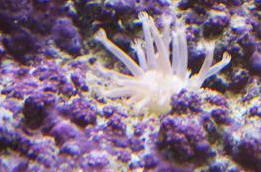
|
|
Corals ~ A Dummies Guide? Slug/Nudi ID, Tube
Polyp ID -12/26/2007 Good morning and Merry Christmas All,
So, I've finally gotten into some soft corals (tube polyps
and polyps) and I believe I may have a stony coral of some sort
that may not be doing so well (came in on some liverock).
I'll emphasize that I LOVE your website and you may be
familiar with my name from previous emails over the years...
however, I was curious as to whether you could recommend a book
for hobbyists just getting started with corals. I find your site
is likely better for people who know what they have and know what
they're talking about when it comes to corals. Is there a
good book you could recommend? <If you're looking for a
very simple guide, you can try this:
http://www.asira.org/caresheets As for books on captive coral
care, "Aquarium Corals" by Eric Borneman is one.
There's also, "The Super Simple Guide to Corals" by
James Fatherree you might like.> Thus far, it seems like the
fish stores I go to recommend soft corals for a beginner coral
hobbyist as they are easier to care for. I'd like to find a
resource that can guide me to repairing/nurturing the stony
corals that came in on the liverock and so as I can feel
comfortable in being responsible in buying stony corals down the
road and be able to care for them. <Hmm... it will be more
difficult to care for dying corals than for healthy ones. Why not
try starting out with healthy, cultured frags first?> Of note,
the stony corals have been around since about July. One little
colony seems to be dying (turning brownish) because it is shaded
within the tank. <Corals often change color to adapt to
different lighting conditions. Such a change, alone, is not a
sign that the coral is dying, or even unhealthy. Now, if it
bleaches out, then you have a problem and need to move the coral
and feed it generously until it gains its color back.> The
other 3 little colonies seem to be ok but they certainly
aren't growing fast and are too small for me to identify
them... but from the pictures on your site, they look like
stonies. Anyhow, a book/resource recommendation would be
grateful! <See above.> Merry Christmas and a Happy New
Year! <...and to you too :)> P.S. I mentioned to Bob that
I'd eventually get a picture of that little slug/Nudibranch
that was crawling in amongst my tube polyps the other day... it
is attached. It's about an inch long. Do you have a specific
ID on those tube polyps... other than me calling them...
'tube polyps'?? <Sorry I can't even begin to ID
the slug/Nudibranch for you from that picture (not focused
enough). The "tube polyps" you have are not a stony
coral (nor do they have calcified tubes). They are Zoanthids,
colonial anemones/corals. Please see here:
http://www.wetwebmedia.com/zoanthid.htm
Best,
Sara M.>
|
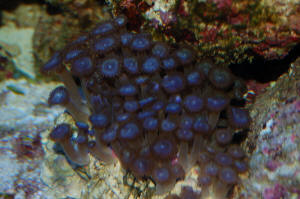 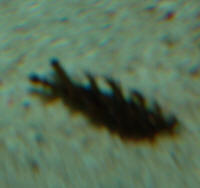 |
Anemone or Coral Hitchhiker? Corallimorph:
Pseudocorynactis spp.- 12/19/07 Hi Crew, <Hi
Russ> I'm sorry to say that this is the second time in as
many weeks that I have darkened your door with an ID request, and
it's not for the want of looking on the web for info. <No
worries, we're here to help. Besides, it's difficult to
look something up when you don't know what it is, eh?> Last
time, it was hastily purchased snails which, it turns out, were
predatory, and had to be returned (I know, I know - but a lesson
was learned from the experience), but this time I'm not so
culpable, save for the purchase of a few small pieces of live rock.
I have, it seems, a nocturnal, bright pink soft coral or anemone
(I'm guessing anemone, but hey, I've really no idea).
<Does indeed look like an anemone, but is actually a beautiful
little Corallimorph of the genus Pseudocorynactis, commonly called
a ball anemone/ball Corallimorph. For more information/photos,
please Google our site, and the net, using
"Pseudocorynactis". If you have Eric Borneman's
"Aquarium Corals" book, see page 198. There are several
photos/some info at this WWM link to get you started:
http://www.wetwebmedia.com/mushrmidfaq2.htm.> It's only ever
fully out first thing in the morning and is back in the hole it
lives and out of sight within a minute of the lights going on,
<Typical - nocturnal.> so getting a photo with a point and
shoot camera is a little awkward (autofocus generally autoblurs,
Grrr), <Frustrating, I know - helps if you turn off all
pumps/stop water movement, and use a macro setting if available -
icon is usually a small flower.> but here's the best I
have... <<anemoneid.jpg>> <Pretty.> It's
about 1 inch across. My questions to you guys, other than 'what
is it?', are, 'is it a danger to fish/crabs/snails/corals?
<Nope. Likely more of a threat to resident pods/zooplankton that
happen by.> (I currently only have crabs and snails, and
don't want to buy fish/corals if this thing is likely to harm
them, without first removing it)', <Understandable.> and
if it's safe, does it need feeding? <Not a whole lot is
known about their care, but they're thought to feed on
zooplankton/pods and such, so you might want to offer it some meaty
bits (mysis/fish/etc) every so often at night, when the tentacles
are extended.> I was also wondering if the white patches may
mean its not too well? <Not sure about that, may just be a
normal patterning?> Any help gratefully accepted. If you need a
better photo, I'll try to get one. <Nope, we're good to
go!> Best regards <Same to you, Russ.> Russ - Sheffield
UK
<Take care -Lynn.> |
|
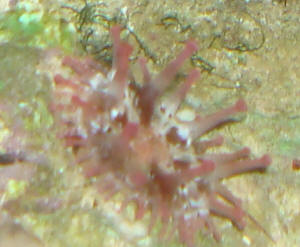
|
Question re: Identification of corals'¦
Aiptasia 11/04/2007 Hello guys, <Hi Lynne, Mich here.> I
am attaching a couple of photos (sorry they are not the best) of
some corals that are growing and spreading quickly in my aquarium.
<Heehee! I bet they are!> What type of coral is this? <You
have Aiptasia, a nuisance if there ever was one... will kill most
any other coral it comes in contact with as you have seen with your
Caulastrea. More here about this pest that easily reaches plague
proportions:
http://www.wetwebmedia.com/marine/inverts/cnidaria/anthozoa/Aiptasia/aiptasia.htm
> The store said it was pink tip tulip coral or something like
that. <Oh good grief! Please tell me you didn't actually PAY
for this 'coral'. I've got a bridge and some prime real
estate in the Pocono Mountains for sale'¦ You could build
a casino! Interested in buy either?> Well I also have I was also
wondering what type of behavior can I expect from this coral.
<Did you see the Star Trek episode titled 'The Trouble with
the Tribbles'?> When it came in contact with my Candy Cane
coral it killed those and seems to be taking over. <Yes indeed.
Is what it does.> Any information you could provide me on this
type of coral and its behavior would be much appreciated. <Nuke
it! Some removal options here:
http://www.wetwebmedia.com/ca/cav1i3/aiptasia_impressions/aiptaisia_impressions.htm
Though I would recommend avoiding the flambéing method
someone recently wrote in and suggested'¦> Thank
you!
<Welcome! Mich>
Lynne |
|
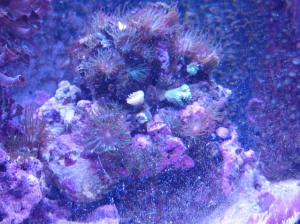 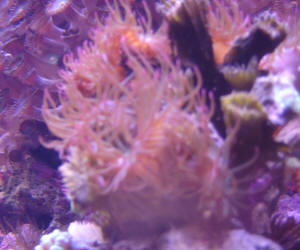
|
Hydrozoan, Coral, or worm? -11/20/07 Hello there.
I have a question on an ID, and unfortunately cannot get a picture for
you right now (I lent my camera to a "friend" and have not
been able to retrieve it). The creatures are in small clusters of tubes
less than 1mm diameter and about 5-8mm long. The tubes are a
red/burgundy/brown color while the heads on two of the clusters have
tan "heads" and a third has green "heads". The
"heads" are tentacles about 3-4mm diameter and only extend
when the lights are on and retract when disturbed. <Can you could
the tentacles on the "heads?" If there are 8, it's
probably an octocoral of some sort.> I have a 20g tank with about
20# live rock of various origins and about 4" fine sand w/ some
rubble and crushed shells, an 8g DSB refugium (just recently added) for
NNR/zooplankton, dual 65w CF lighting w/moonlights, SeaClone 100
(difficult and tedious to tune/operate efficiently) and Tetratech PF150
(nice "surge" action). Primary circulation pumps about 250
gph from Fuge plus 2 additional PH @ 100+gph. I have been setup for
about 16 months, but had some problems over the summer; temp climbed to
116+ for a few days and I lost almost everything. <yikes> A
chiller is in the works for next season. <...or an air conditioner
and a fan or two.> My water parameters all check out fairly well:
Ammonia, nitrite, nitrate, phosphate all at or near zero, pH 8.2-8.4,
8-10dKH, calcium 380-440 (these are the only tests I currently have).
Current livestock includes royal Gramma, Rainford goby, fire shrimp,
porcelain crab, 6 hermits, Astrea, Cerith, Nassarius, flower anemone
(the only survivor the heat, but color changed from brownish green to
neon teal-green), Zoanthids, green star polyps, Capnella, striped
Discosoma, Caulastrea, Blastomussa, and Pavona, as well as numerous
worms, sponges, and ascidians that I can recognize. Everything seems to
be doing well, no interactions with these small creatures, but I became
more interested in them when I noticed the third colony with the green
heads (indicating chlorophyll/zooxanthellae?). <Not necessarily...
but tis a curious thing anyway. It's possible the white ones are
bleached and the color is returning to some of them.> I have poked
at these without being stung, <lol> and the tubes are flexible,
almost like stiff rubber, not brittle or calcareous. I have spent many,
MANY hours reading through your site, and have gained much knowledge
from it and appreciate all the wisdom you share. <cool> The
closest pictures/descriptions I found have been hydrozoans, but nothing
quite like what I have. <Hmmm... you know I'm going to tell you
that it's impossible to say without a photo, but what you're
describing sounds like a clove coral or maybe an encrusting
Gorgonian.> I apologize for the long message, though I would rather
share excess information than not enough. Thank you all for your time
and attention. <No problem. Do see if you can borrow a camera or get
yours back. We should be able to help you more with a picture.>
Brian B <Best,
Sara M.>
| Star Coral ID? Zoanthid? Hello again. You
guys are SO helpful...I can't stay away. <Me neither!> I
researched this all over your site, but I can't seem to find an
answer. I really need to know if I have pompom hydroids or this
beautiful sulfur yellow star coral. They both resemble each other
enough to worry and I can't tell from your images...so maybe
you could tell me? <Yes> At
http://www.wetwebmedia.com/alcyoniidsii.htm it shows some little
yellow star/sulfur corals. I believe I have that in my aquarium.
Another aquarist threw it out while cleaning his tank, and told me
he'd give me a puff of it, so I've incorporated it into the
aquarium, however at http://www.wetwebmedia.com/hydrozoanfaqs.htm
it has something that looks a bit like them also. I don't want
to make a mistake and get a coral that will sting me such as a fire
coral, and I believe it's saying that the hydrozoans do sting?
I'm not sure after reading that. <They do sting...
hydropolyps... some folks, body areas (less callused) more/less
than others> My coral is attached, and I want to know what it is
so I can be sure before keeping it. It comes in a nice soft mat and
hasn't stung me or anything, and it's kind of like a little
carpet of beautiful yellowish flowers. <Mmm, sounds more like a
Zoanthid...> Now, remember, this was given to me as one little
carpet clump and because I just set up this new tank, I put it in
there, stuck between some rocks. I can take it out just as well,
but it's so pretty...is it truly that dangerous if it's
pompom? <Is not a Hydroid...> Here is the image. Please let
me know what it is. I am worried. I don't want to ruin my
beautiful aquarium with something that can kill me potentially or
injure me. Thanks so much, ahead of time. Naynay <Like the
Hawaiian goose phonetically? I would not be concerned here...
Please read here: http://wetwebmedia.com/zoanthid.htm and the
linked files above... for background info.. Send along a more
close-up, highly resolved image if you'd like a better ID.
Cheers, Bob Fenner> |
|
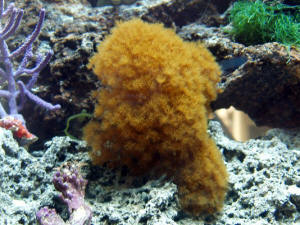
|
| Coral I.D.... Lemnalia and Discosoma neglecta
<Greetings random aquarist, Mich here.> I searched for about
an hour on various sites and could not come up with any conclusive
answers. I was hoping someone there would be kind enough to
identify the coral on the left side of this pic I attached and the
mushroom on the right. These two pieces were given to me by a
friend but he did not know what they are for sure. He said the one
was a colt coral. <The coral on the left does not look like a
Cladiella to me. I suspect a Lemnalia or possibly a Sinularia, if
it is either and it starts to look like it's on it's way
out you will want to remove promptly from the tank as both can be
toxic to tankmates. The mushroom is a Discosoma, looks more like a
neglecta to me but could be a carlgreni.> Regardless of what
they are...they are looking quite healthy and happy in my nano
tank. <Glad to hear.> I was just really itching to know
exactly what type of species they are. I would like to tell others
who ask me about them correct information. <Hope this helps.
Mich> |
|
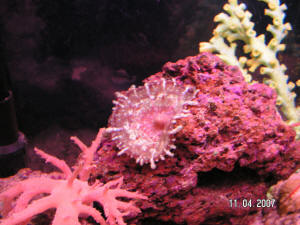 A dyed Sinularia at that. A dyed Sinularia at that.
|
Coral ID - need a better pic 07/27/07 Hi
there and thanks in advance for your assistance. I cut this piece
of coral from the main piece of LR which it started life upon and
placed it elsewhere in the tank in fear of it being covered over by
a toadstool leather coral (it would not have got much light where
it was). Its been over week now and it has stuck itself where I
placed it and seems to be doing great which is a result but I have
no idea what it may grow to become, any ideas on the ID of this
little fighter? <So, this was originally found below the
toadstool leather? Judging from what you're telling me more
than from the photo, I would guess that it's a baby toadstool
leather. Leather corals often drop babies. Otherwise, I can't
tell you much from the photo.> Regards K.
<Best,
Sara M.> |
|

|
|
|

